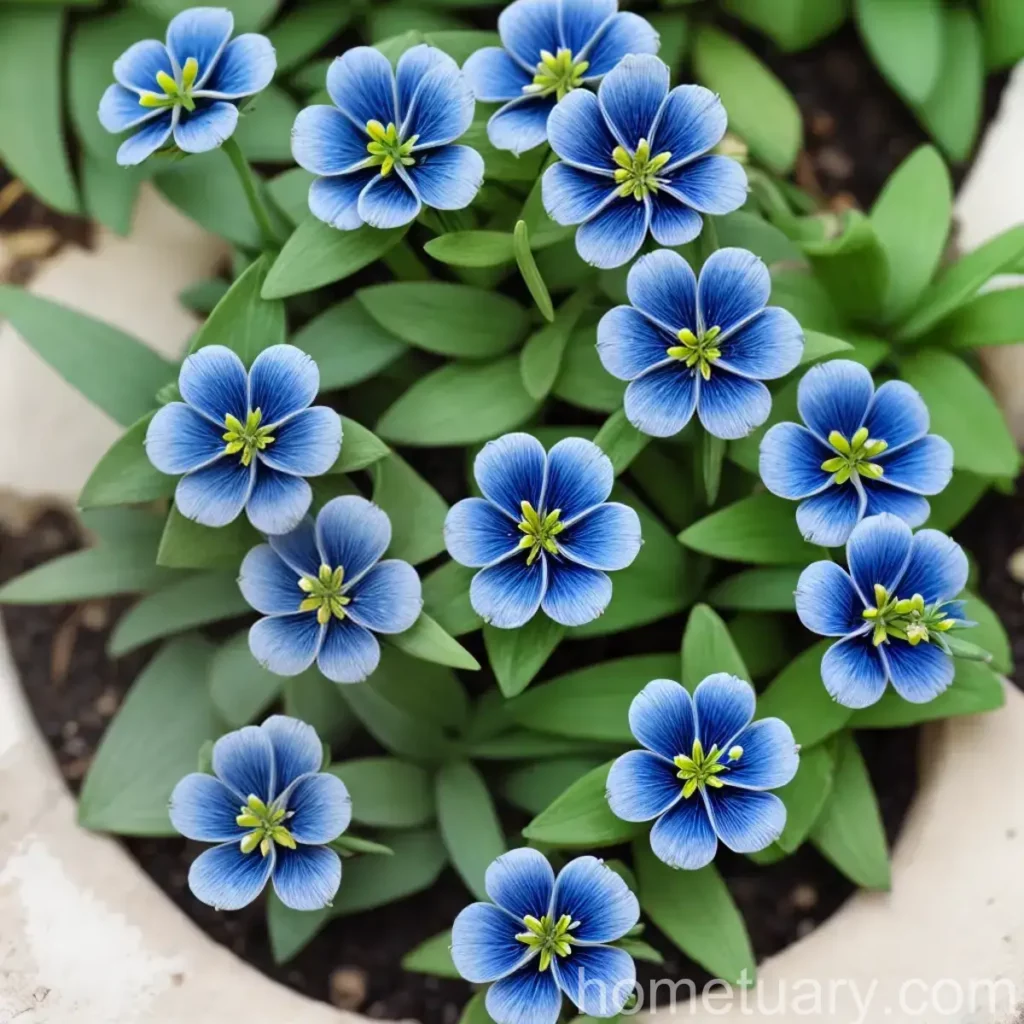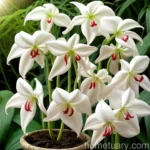Blue Pimpernel (Anagallis monelli): A Comprehensive Guide
Blue Pimpernel, scientifically known as Anagallis monelli, is a charming and delicate flowering plant that belongs to the Primulaceae family. This plant is admired for its striking blue flowers and its ability to thrive in various growing conditions. In this comprehensive guide, we’ll delve into the various aspects of blue pimpernel, including its cultural preferences, uses, care tips, and much more. Whether you are a novice gardener or an experienced horticulturist, this guide is designed to provide you with valuable insights into the world of Anagallis monelli.
What is Blue Pimpernel (Anagallis monelli)?
Blue Pimpernel, or Anagallis monelli, is a low-growing perennial plant that is native to the Mediterranean region. It is characterized by its delicate, star-shaped blue flowers that bloom profusely, adding a touch of elegance to gardens and landscapes. The plant typically reaches a height of 6-8 inches and forms a spreading mound of foliage adorned with blooms throughout the growing season.
Key Takeaways – Blue Pimpernel (Anagallis monelli)
Before we delve deeper into the specifics of blue pimpernel, let’s take a moment to highlight some key takeaways about this captivating plant:
- Botanical Name: Anagallis monelli
- Common Name: Blue Pimpernel
- Family: Primulaceae
- Plant Type: Perennial
- Flower Color: Blue
- Sunlight: Full sun to partial shade
- Watering: Moderate
- Soil Type: Well-draining, fertile soil
- Uses: Ground cover, container gardens, borders, and edging
- Special Features: Attracts pollinators, low maintenance, suitable for rock gardens
Now, let’s explore the various aspects of cultivating and caring for Anagallis monelli in greater detail.
Culture
Cultivating blue pimpernel can be a rewarding experience, as this plant offers a delightful display of delicate blue flowers. Understanding the cultural preferences of Anagallis monelli is crucial for ensuring its optimal growth and blooming. Here are the essential cultural considerations for blue pimpernel:
Uses
Blue pimpernel serves multiple purposes in the garden and is a versatile addition to various landscape designs. Its primary uses include:
- Ground Cover: The low-growing habit of Anagallis monelli makes it an ideal choice for ground cover in sunny to partially shaded areas.
- Container Gardens: Blue pimpernel can be grown in containers, hanging baskets, or window boxes to add a pop of color to patios, balconies, or outdoor living spaces.
- Borders and Edging: The compact growth habit and charming flowers make blue pimpernel a suitable option for edging pathways and borders in garden beds.
Water
Anagallis monelli has moderate water needs and prefers consistently moist, well-draining soil. While it appreciates regular watering, it is essential to avoid overwatering, as waterlogged conditions can lead to root rot. During hot, dry periods, maintaining adequate moisture levels is crucial to support healthy growth and blooming.
Sunlight
Blue pimpernel thrives in full sun to partial shade. In regions with intense summer heat, providing some afternoon shade can help prevent the plant from wilting. When grown in partial shade, the plant may exhibit slightly more vigorous growth, but it may produce fewer flowers compared to those grown in full sun.
Fertilizer
Applying a balanced, all-purpose fertilizer to blue pimpernel in early spring can support healthy growth and prolific flowering. A slow-release granular fertilizer can be incorporated into the soil at the beginning of the growing season, providing essential nutrients to the plant as it develops. Additionally, supplementing with a liquid fertilizer every 6-8 weeks during the growing season can further enhance the plant’s vigor and flowering potential.
Soil
Providing well-draining, fertile soil is essential for the successful cultivation of blue pimpernel. The plant thrives in soil that retains moisture without becoming waterlogged. A rich, loamy soil with good organic content is ideal for supporting the growth and blooming of Anagallis monelli. Prior to planting, amending the soil with organic matter or compost can help improve its structure and fertility, creating an optimal growing environment for the plant.
Pruning
Minimal pruning is typically required for blue pimpernel. However, deadheading spent flowers throughout the blooming season can encourage the plant to produce new blooms and prolong the flowering period. Additionally, light pruning to remove any leggy or overcrowded growth can help maintain the plant’s compact and tidy appearance. Pruning tasks can be performed using clean, sharp garden shears to promote plant health and aesthetics.
Propagation
Anagallis monelli can be propagated through several methods, including division, stem cuttings, and seed sowing. Each propagation technique offers a reliable way to propagate the plant and expand its presence in the garden or landscape. Here are the primary propagation methods for blue pimpernel:
- Division: Dividing established clumps of blue pimpernel in early spring or fall can yield new, healthy plants. Carefully separate the clumps into smaller sections, ensuring that each division has roots attached, and replant them in suitable locations.
- Stem Cuttings: Taking stem cuttings from healthy, non-flowering shoots in spring or early summer presents an effective means of propagating blue pimpernel. The cuttings can be rooted in a suitable propagation medium, such as a mix of perlite and peat, to establish new plants.
- Seed Sowing: Collecting and sowing seeds from mature blue pimpernel plants allows for the production of new seedlings. Sow the seeds in a well-prepared seed-starting mix and provide appropriate moisture and warmth to support germination and seedling growth.
Container Popularity
Blue pimpernel is well-suited for container gardening and is popular among gardeners who appreciate its compact growth habit and charming blue flowers. Its versatility as a container plant allows it to thrive in various settings, from patio containers to hanging baskets and window boxes. The plant’s adaptability to container culture makes it a valuable addition to urban gardens, small outdoor spaces, and indoor environments.
Container Common Diseases
When cultivating blue pimpernel in containers, it is essential to be mindful of potential diseases that can affect the plant. While Anagallis monelli is relatively resistant to most common diseases, it can be susceptible to certain issues when grown in containers. Here are some common diseases to watch for:
- Root Rot: Overwatering or poor drainage in container-grown blue pimpernel can lead to root rot, causing the plant to exhibit wilting, yellowing foliage, and overall decline. Ensuring proper drainage and allowing the soil to dry out slightly between watering can help mitigate the risk of root rot.
- Powdery Mildew: In humid or poorly ventilated conditions, blue pimpernel may be prone to powdery mildew, characterized by the development of a white, powdery coating on the foliage. Adequate air circulation and the use of fungicidal treatments can help manage this fungal disease.
Disease Diagnosis
Diagnosing and addressing diseases in blue pimpernel is essential for maintaining the plant’s health and vitality. Proper identification of the symptoms and causes of diseases can guide effective treatment and management strategies. Here are some key points to consider when diagnosing diseases in blue pimpernel:
- Symptoms: Observe the plant for any unusual changes in foliage color, texture, or general appearance. Look for spots, lesions, discoloration, wilting, or unusual growth patterns.
- Environmental Factors: Consider the growing conditions, including sunlight exposure, water management, soil quality, and humidity levels, as these factors can contribute to the development of diseases.
- Pathogen Identification: When possible, identify the specific pathogen or causal agent responsible for the disease, whether it is a fungal, bacterial, or viral pathogen. This information can inform targeted treatment approaches.
Common Pests
Blue pimpernel is relatively resistant to pest infestations, but it can be affected by certain common garden pests. Keeping a vigilant eye on the plant and implementing preventive measures can help minimize pest damage. Here are some common pests that may affect blue pimpernel:
- Aphids: These small, soft-bodied insects can congregate on the tender shoots and new growth of blue pimpernel, sucking sap from the plant and causing distortion of the foliage. Regularly inspect the plant for aphid activity and use insecticidal soaps or horticultural oils to control infestations.
- Spider Mites: Spider mites are tiny arachnids that can cause stippling and webbing on the foliage of blue pimpernel, leading to reduced vigor and overall plant health. Increased humidity, regular misting, and the use of predatory mites can help manage spider mite populations.
Botanist’s Tips
As a plant scientist with a passion for botany, I find blue pimpernel to be a fascinating subject of study. Here are some exclusive tips and insights for cultivating and appreciating this charming plant:
- Natural Habitat: Blue pimpernel is native to the Mediterranean region, where it inhabits sunny, rocky slopes and well-drained soil. Emulating its natural habitat can help optimize its growth and blooming in garden settings.
- Pollinator-Friendly: The vibrant blue flowers of Anagallis monelli attract pollinators such as bees and butterflies, contributing to the ecological value of the plant. Incorporating blue pimpernel into pollinator-friendly gardens can support local wildlife and biodiversity.
Fun Facts
No guide to blue pimpernel would be complete without a few fun and interesting facts about this captivating plant:
- The common name “pimpernel” is derived from the Old French word “pimprenelle,” which refers to the plant’s five-petaled flowers.
- Blue pimpernel is sometimes referred to as “Blue Pimpernel of Madagascar,” despite not being native to Madagascar, due to its similarly hued flowers to those of the true Madagascar Pimpernel (Anagallis foemina).
Links to External Resources
To further enrich your understanding of blue pimpernel and discover additional insights and resources, explore the following links:
- Royal Horticultural Society – Anagallis Monelli
- Plant Care Guide – Blue Pimpernel
- Missouri Botanical Garden – Anagallis Monelli
In conclusion, Anagallis monelli, or blue pimpernel, is a captivating plant that offers a wealth of ornamental and ecological benefits. Whether utilized as a ground cover, container plant, or border edging, its charming blue flowers and low-maintenance nature make it a valuable addition to diverse garden settings. By understanding and implementing the key considerations outlined in this comprehensive guide, you can cultivate and appreciate the beauty of blue pimpernel in your own garden or landscape.
Remember to explore the provided external resources for further information and insights into the world of Anagallis monelli. Happy gardening!
Keywords: Anagallis monelli blue pimpernel, Blue pimpernel flower, Anagallis monelli plant, Blue pimpernel characteristics, Anagallis monelli care tips, Blue pimpernel growing guide, Anagallis monelli varieties, Blue pimpernel cultivation, Anagallis monelli planting instructions, Blue pimpernel maintenance, Anagallis monelli watering needs, Blue pimpernel sunlight requirements, Anagallis monelli soil preferences, Blue pimpernel blooming season, Anagallis monelli perennial plant, Blue pimpernel medicinal properties, Anagallis monelli pollinator-friendly plant, Blue pimpernel natural habitat, Anagallis monelli propagation methods, Blue pimpernel container gardening, Anagallis monelli landscape use, Blue pimpernel wildlife attraction, Anagallis monelli drought tolerance, Blue pimpernel garden design, Anagallis monelli pest control, Blue pimpernel disease prevention, Anagallis monelli seasonal care, Blue pimpernel pruning techniques, Anagallis monelli companion plants, Blue pimpernel flower arrangements, Anagallis monelli indoor cultivation, Blue pimpernel gardening tips, Anagallis monelli hardiness zones, Blue pimpernel landscape ideas, Anagallis monelli unique features, Blue pimpernel flowering period, Anagallis monelli foliage color, Blue pimpernel native plant, Anagallis monelli ground cover, Blue pimpernel border plant, Anagallis monelli water-wise species, Blue pimpernel seasonal interest, Anagallis monelli plant arrangement, Blue pimpernel garden maintenance, Anagallis monelli seed propagation, Blue pimpernel low-maintenance plant, Anagallis monelli soil pH requirements, Blue pimpernel shade tolerance, Anagallis monelli annual plant, Blue pimpernel cut flower.















